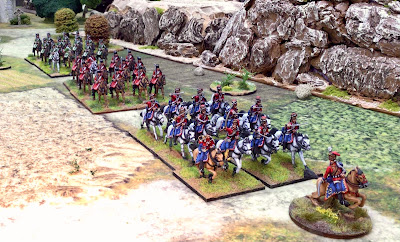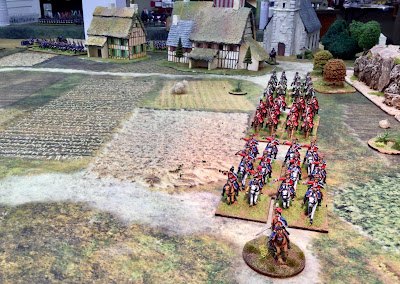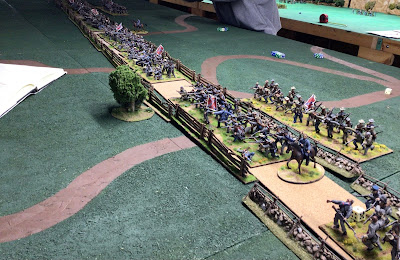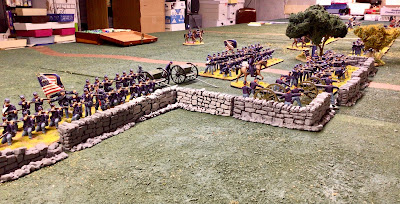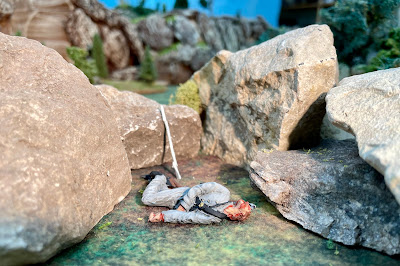I get a lot of questions from my followers on this blog, Facebook and other social media, so I thought that I would open up the old mailbag and answer some of the questions therein
1. How did you make the blue sky back drop that we see in your photographs?
I use a piece of sky blue light colored felt and spray random cloud patterns on the felt with white spray paint. Caution, do the spray painting outdoors rather than in the confines of your basement. Trust me on this one.
2. Where did you get the game mats that are on your table
I now purchase all of my table mats from Cigar Box Battle Mats. These are my go-to game and table mat for every period of war gaming that I do. You can fold the mats up into a compact rectangle and transport it to the convention site - very easy to do. I now longer mess around with terrain boards or canvas mats. You have to roll up the canvas mat and then you end up with a 6ft long tube of canvas that does not easily transport. Finally, the Cigar Box mats look better than anything that I could do on my own. I simple overlay the mat with buildings and terrain pieces, or place books or pieces of pink insulation foam under the mat to create hills and contours.
3. What types of materials do you use for basing your figures?
I recently did a tutorial on how to make fences and roads and I used the same mixture of goop on the road sections as I do on figure bases. Basically, I buy a tub of pre-mixed wall board paste (also known as Spackle) and mix brown paint into the tub. Then I stir the paint until it looks like chocolate icing or pudding. It later dawned on me that I could go to the hardware store and buy a tin of brown acrylic household paint at a more economical price.
I use a small artist's trowel and work the goop around the figure bases and between the legs. If your goop starts to get too thick from being in the air, simply add a little bit of water to your container of goop and stir it in. Next, I sprinkle some "fine" railroad ballast material from Woodland Scenics and shake off the excess material. Let the base dry overnight and then start dry brushing highlight colors over the base. After this, I glue on some tufts and static grass and set the base aside for about an hour. You are now finished basing!
4. How do you prime your plastic figures so that the primer and/or paint does not flake off?
After experimenting with various brands, I have found that Army Painter primer is the best for plastic figures. The primer leaves a sort of shiny color on the surface that is really hard fasting, almost like the effect of gloss spray coating. Some of the basic auto paint primer work well too. The only primer brand that I would avoid for plastic figures is the Vallejo brand. I had big chunks of primer or painted figure surfaces flake off. Vallejo may be ok for metal figures, but definitely not for plastic figures.
On a related topic, how do I prepare the plastic figures before I prime them? I wash them in the sink with hot water and liquid dish washing detergent. I sometimes, but not always, give them a good scrubbing with one of those dish washing sponges that has a sponge on one side and a plastic scrub brush on the other side. After this, I rinse the soap off of the figure with warm water. I shake each figure dry to get the water out of some of the deep cuts / crevasses on the figure and then set them on a towel to air dry.
5. How do you organize your AWI and SYW armies?
I use a 1 to 20 ratio of figures to men for most of my armies. Thus my infantry figures are largely 30-figure infantry regiments. I organize my cavalry into squadrons of 12 figures and have 2 or 3 squadrons per regiment. For the AWI, tend to go with a 1 to 10 ratio since the regimental strengths in that conflict were very small.
6. What or who has influenced your war games the most?
I started war gaming around 1986 when I went to the Little Wars convention in the Chicago area and got acquainted with Dennis Smail of RSM miniatures. Dennis had put on a fabulous looking SYW game with RSM figures (his own company). I fell in love with the RSM figures and was a regular orderer of figures from RSM. One day Dennis invited me to come to Lexington, KY to play in a couple of games over the weekend. Dennis always had great looking terrain and was very good at designing scenarios.
Duke Seifried was certainly an influence for me. Oftentimes our war games would be set up next to each other at a convention, so I'd talk with Duke about all things related to war gaming. I was also attracted to Duke's sense of the epic spectacle of a game. You know where that led me today.
Peter Gilder and his Wargame Holiday Centre had a huge influence on how I looked at war gaming. I visited the WHC when Mike Ingham was running the business and I was mesmerized by the huge tables (3 table of 6ft by 32ft, although one of the table was actually 2ft by 32ft) and the large battalions of figures used in Peter's In The Grand Manner rules.
So from these titans in the hobby, I like to put great looking terrain on the table, run a game that tends toward the spectacle, and I like to use multiple large and parallel game tables to provide depth and wide open flanks.





